What is POD? Print On Demand DropShipping explained
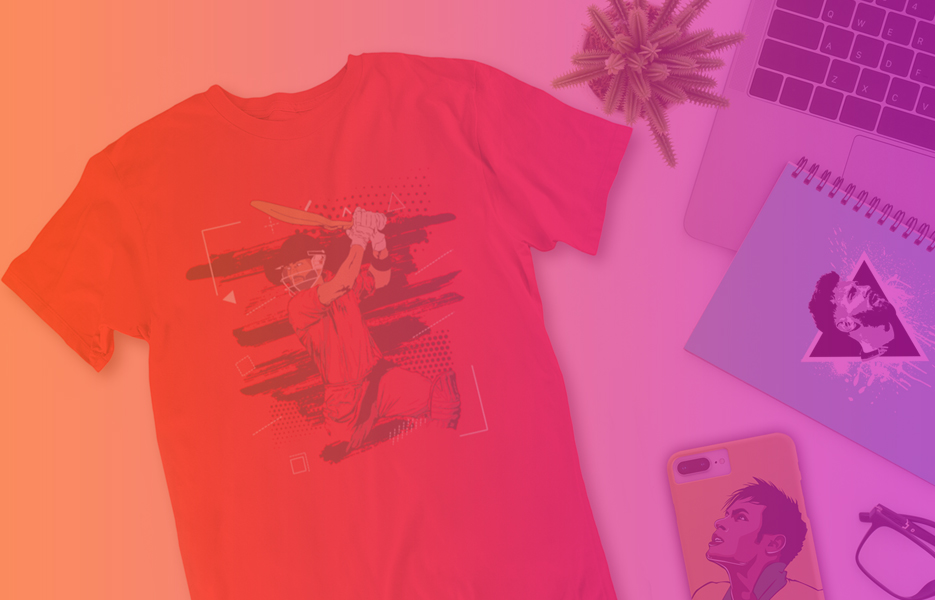
What is POD?
Let’s start with a quick definition, so we can get into detail about what POD is, how it compares with DropShipping, why you should do it and so on.

Businesses that are creating designs to print on demand work with suppliers that print their designs for them, and then despatch the finished items directly to customers. If it sounds familiar as a form of DropShipping, then you’d be right – it is a form of DropShipping, just with the added step of design work needing to be created.
What can be printed on demand?

Print on demand generally refers to clothing, but there are a whole world of items that you can think about creating using print on demand services. Here are just a few ideas to inspire you:
- T-Shirts
- Stickers
- Mugs
- Vinyl wall decals
- Hoodies
- Stationery
- Towels
- Prints of artwork onto canvas
- Hats
- Bags such as cotton shopping bags
- Notebooks
- Books
- Phone Covers
For more specifics about which products you can print on demand, check out print on demand suppliers – some suppliers will be able to print on different materials. You may need to engage with several suppliers to get the products you want for your range.
Why do customers want print on demand products?
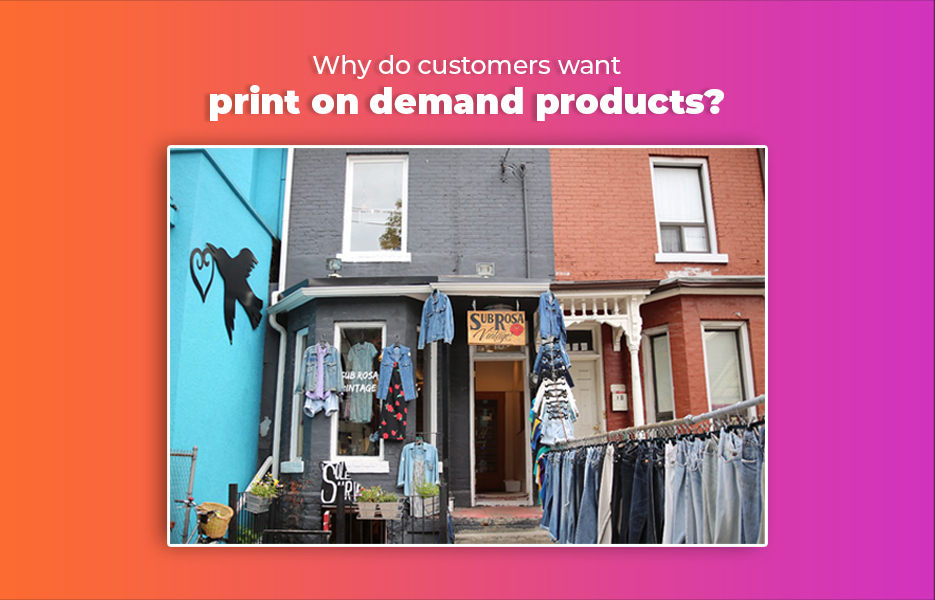
Before eCommerce grew to what it is today, if you found an amazing store with unique products hidden away down an alleyway that not many people knew about, you could keep that store secret. Your friends, upon admiring your t-shirt, hat, hoodie and so on wouldn’t know how to go about finding it in order to buy one for themselves – unless they got lucky and discovered your store for themselves.
Unfortunately for those of us who want a unique look today, or want products that nobody else has, it is incredibly easy to find an item that your friend has, or that you have seen on a TV personality. The world’s delightful hidden boutique stores are now all online, and customers have access to a myriad of products available to them. In many cases, they won’t even need to visit more than one or two marketplaces to find what they are looking for, since so many businesses sell on Amazon and eBay.
Customers want those unique items still. That’s why customers buy print on demand items.
Benefits of print on demand
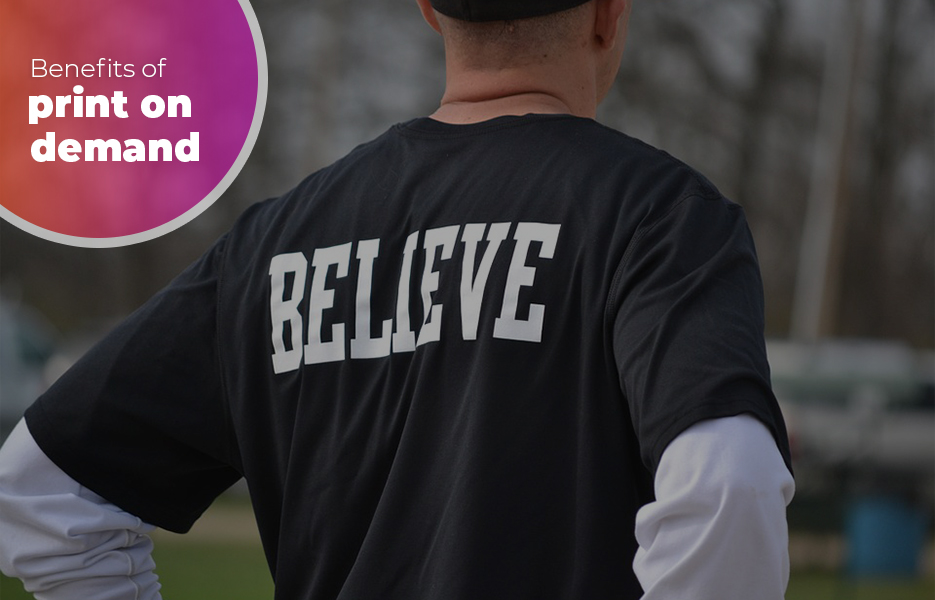
The benefits of print on demand are plenty – and if you’re considering creating print on demand products, then you’ll already have thought of some of them. Here’s our thoughts on why print on demand is great for businesses.
No upfront costs
Since you don’t pay your supplier until you’ve received payment from your customer, print on demand is a great way to start your business without needing to put any cash in upfront. The only thing your business is going to cost you is time to creating your designs (which, if you’re an artist and create your designs for fun, you can literally monetise that hobby!) and marketing your products. Since your marketing efforts are likely to include creating your social media following that you will need images for too, if you’re a creative person this will give you a fantastic outlet for your talent.
You don’t have to invest in stock
Sure, it might be cool to print your design onto hundreds of t-shirts and mugs and have them ready to dispatch to customers, but that means having cash available to spend on them and space to store them. If you don’t have that money available and a loan isn’t something that would suit your business, then print on demand is a great way to get started marketing your designs.
No waste
If you do happen to have cash to invest in stock, using print on demand can still be a useful part of your strategy. Let’s say you order a bunch of products and it turns out that a particular design isn’t popular with customers. The products you’ve ordered with that design become what’s known in the industry as dead stock, and you might find yourself with stock cluttering up your home, office or warehouse. By using print on demand before investing, you’re effectively reducing the risk in doing so, because you’ll already know whether customers want the design or not. You’re reducing the chance of having to deal with dead stock – which also means no discounting your products in order to clear them and get your money back and move forward with another design.
No storage costs
Products like mugs, notebooks and hoodies can take up a lot of room, so if you don’t have any place to store your items, you might need to invest in storage – which can get expensive. Let’s face it, if you’re just starting out in business selling custom notebooks and hoodies, your garden shed isn’t going to work for you – you need proper storage, with appropriate heating and lighting for you to complete picking and packing tasks. If you’re printing on demand though, none of these issues are a concern, as you’re ordering each item from your printer as you need them, and your printer is dealing with shipping the items. That means if the only space you have to call your own is your bedroom in your childhood home, you don’t need to shell out for those costs, and you can get on with building your business.
No delays
Most print on demand companies often print and despatch the same, or next working day. That means your customers receive their orders quicker – and fast service equals positive feedback and reviews, which are essential when growing a new business. Your customers will rarely, if ever, encounter problems with items being out of stock, meaning your customers will come to know they can trust you as a seller.
Customer interest
Since you’re the one creating your designs, you can increase the amount of designs you have available as often as you can produce them. If you’re creating designs that are popular with fans of a particular literary, TV or movie genre, or gamers, then producing new designs regularly means that customers will remain interested in your products – meaning more potential for sales!
Complete control over your designs
Have you ever had an item you wish was ever so slightly different in some way? Perhaps a cool mug that you liked, but it didn’t hold quite enough tea for your liking? What about a t-shirt design that wasn’t quite the right colour? Most of us have encountered this sort of thing at some point. As a designer, this might be frustrating to encounter – especially if it was restricted by the company you were working for.
A major bonus of creating print on demand items is that you have total control over the designs of the items you’re selling – within reason. Sure, you might be restricted to the blank items your supplier has – but often they will have options available for you to choose from, such as different sized mugs, t-shirts with round and v-necks and so on. On top of being able to choose the items you want, you’re in control of where your design is applied – so, you might choose to have a hoodie printed across the chest, but also down one arm. A different hoodie design might have a print across the chest and on the back. A notebook might have a print on the front AND back cover, or if you’re printing a t-shirt, you might have the print just on the back, rather than on the front. You get what we’re saying here – you get to pick what your designs are, and where they are applied.
Custom packaging
This can be an option with some suppliers – meaning that as your customers receive your order, they get to see your branding, either on the packing material itself, or on a sticker with their address on. This is important if they’ve bought from you via a marketplace, because it helps them to remember your company, and means that if they decide to order another item, they can find you easier. Don’t forget to add your social media handle(s), and your website address to any packing customisation you can. It’s a small detail, but every follower you can gain on social media is a potential customer, and don’t forget, if they share any of your content with their followers, there’s a chance there is a potential new customer amongst them.
While we’re talking about packaging, it’s also worth contacting your supplier to see if packing slips can be customised – even if it is just with a note. All packing materials and slips are opportunities to engage with your customer and encourage repeat business, so don’t waste them!
Use print on demand alongside other business
Businesses that are DropShipping, or doing something different entirely can add print on demand sales to their offering to boost potential income. You might be a wedding photographer capturing gorgeous landscape images that you offer prints of on canvas – using a print on demand service. Perhaps you’re a seamstress that also creates YouTube tutorials, and you want to create tea towels or notebooks for giveaways. Or maybe, your business is a coffee shop, and you want to create gift packs with mugs and specialist, high quality teas and coffees that sell online and send worldwide. You might have a whole host of other ideas, but print on demand has the potential to boost your business – and your profits – substantially.
Challenges of print on demand
Although there are a lot of benefits of creating products using print on demand, there are challenges that you will have to face as well. Let’s take a look at some of the issues you might encounter.
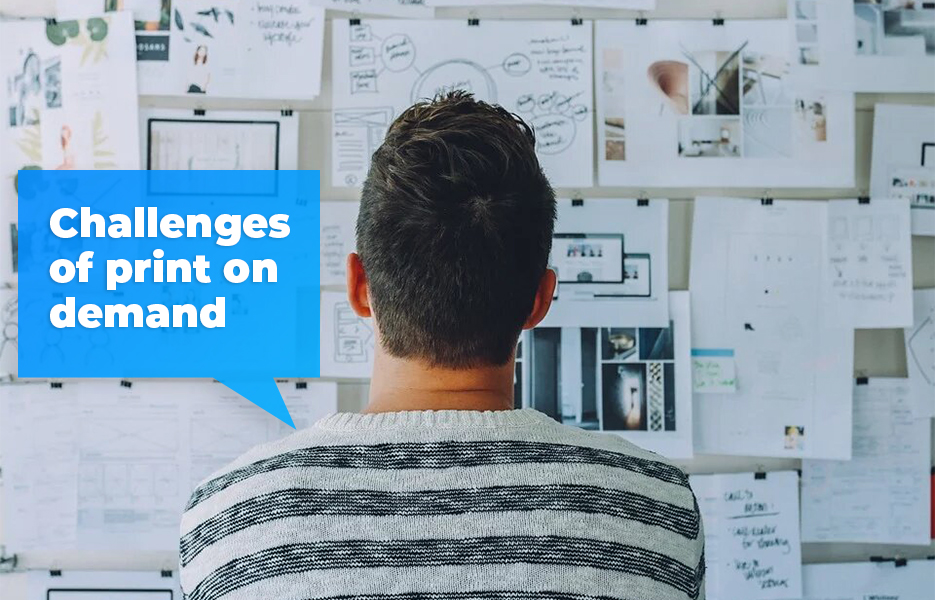
Product costs can be high
Let’s start with the biggest issue first, shall we? If your product costs are high, the profit you make on each item may end up being lower. They may have to be in order to keep the finished product price low enough to encourage customers to actually make sales. Not only have you got to consider the price of each item before you print on it, you’ll need to pay the cost of printing – which might mean your customers decide to buy something else, rather than your product. If you’re producing different items with the same designs, you can shop around for the best price on each item, but bear in mind that this could end up being time consuming. If you’re taking into account and charging the business for your time creating the designs, that’s an additional cost to be factored in too. Adding all these costs up could mean that ultimately, it isn’t a sustainable way to scale your business.
Shipping can be expensive
Your print on demand supplier may not include the cost of shipping in the cost of the item to the customer. That might mean you need to add that cost onto the purchase price of the item, or charge customers for it separately – which then may deter customers from making their purchases. If your customers are buying your products from overseas, this may make your items prohibitively expensive. If you find you get interest from potential customers in a particular country, it may be worth finding a supplier in that country, in order to reduce costs and make more sales.
Predicting best selling designs is difficult
We’ve all encountered the feeling of being incredibly proud of something, only for someone to tell us it isn’t great, or to ignore it. With print on demand sales, you might find that what you consider to be your best designs are ignored by customers. That can be incredibly frustrating – we understand! Although it’s tricky, it can also be part of the fun of print on demand – figuring out what your customers are going to like. However, it’s definitely a good reason to use print on demand rather than investing in stock – especially with new designs.
If you’ve got a good number of followers on social media, you might post hints, or new designs that you’re playing with, and see what interest you get. If your followers aren’t impressed, or don’t engage with the post, you don’t have to shelve those designs – you can still offer them, just be aware those may not make you the sales you would like.
You’re creating your products
Well, technically we know your print on demand supplier is creating your products. But you have to come up with the designs, and pick what you’re going to allow them to be printed on – which means that you have an extra task to do before you can get on with the business of selling the items. If you’re deciding whether to do print on demand or DropShipping, be aware that this could be a significant additional challenge on top of regular DropShipping processes, especially for people who are considering making print on demand sales on top of their day job.
Design skills
We’ve already discussed the cost implications of creating the designs for your products, but actually coming up with designs can be a challenge to your business. If you go through a patch where you’re uninspired and you can’t come up with designs that you’re happy to add to your range then you may find it difficult to grow your business – which will impact on your profits. You might decide to work with another designer to alleviate this issue, but bear in mind that is an extra expense that your business may not be able to sustain.
Mock-up generator models can all look the same
If you’ve been looking for a particular type of t-shirt, or mug, or baseball cap on marketplaces like Amazon and eBay, it won’t have failed to come to your attention that many of the models are incredibly similar. That’s not because all models look the same of course – it’s because sellers of these products have used mock-up generator tools to create the look of the finished product.
Using a mock-up generator means that you don’t need to buy each product, with different colour combinations, to take photos for listing and marketing. That means your costs are lower, but it does mean that your product photos will be incredibly similar. If you don’t want to advertise to your customers that your items are printed on demand, then you might find this a problem.
You could use different mock-up generators to get around this issue – but this will place extra demands on your time. If you’re able, you might order some of your items and photograph them yourself (or you might use the items you ordered as quality control items).But again, this is an extra drain on your resources – both time and money – especially if you need to use a professional photographer, or you need to buy a camera that can produce photos that are good enough quality.
Mark was talking about mock-up generators on the blog recently, so if you’re interested to know more about how they work, and how you can use them in your business, head over to that post.
Limited selection of products
This makes sense when you think about it. There are only so many items that are suitable for the print on demand process, and so your range is limited to what your supplier can print on for you. If you’re hoping for your business to create a huge amount of money for you, you might need to find other ways to diversify and bring in additional money.
If you’re expecting for your business to only ever be print on demand clothing like t-shirts and hoodies, this might not be an issue for you. However, your range will always be restricted by the number of designs you have, so again, you may eventually find that you need to identify other ways to diversify your business.
Quality of finished products is out of your control
Just like with traditional DropShipping, you are relying on an external third party to complete your orders. That means you need to be able to trust that your suppliers are going to create the product that your customer wants, to a high standard, and in a timely manner. Just like anything else that you buy online, before engaging with your intended print on demand supplier, check out reviews, and pay attention to what you find. You’ll almost certainly find the odd negative review, even for the best of the best – that’s normal. But be wary where you find multiple reviews mentioning the same issue, particularly if complaints are around an issue that may affect your customers.
Once you’ve decided on a print on demand supplier you think you’re going to work with, it’s a good idea, before sending orders to customers, to order one or two of your items to check the quality your customers will receive. Some businesses – especially if you are local to them – may be prepared to send out samples of their work, so do your research.
People copying your designs
As big fashion houses everywhere have found for decades, people often want to get the look for less. With the internet providing access to more and more designs, and tools to replicate those designs, a problem you might encounter is people copying your designs – either ripping them off completely, or creating a lookalike – and selling them without your permission.
To try and avoid other sellers out-and-outreproducing your designs exactly, using a watermark, or adding your logo to your images is advisable. Unfortunately, there isn’t much you can do about copycat designs that are ‘inspired by’ your work – as many designers have found in the past. Proving that they have copied your work may be difficult, and if the other seller is overseas, it may be near-impossible to pursue them legally. Not only that, those legal costs would quickly mount up and impact your bank account. Consider what Coco Chanel said about people copying your designs:
If you want to be original, be ready to be copied.
Scaling up can be difficult
With all the challenges we have spoken about here, it’s clear that creating print on demand products and building your business to make a profit can be tricky. However, if you’ve a passion for design, and you create a great plan with strong business acumen, then it is likely that your business can be a success. If you’re looking for your business to become your main income though, you may need to (at least, in the beginning) add other strings to your bow – like mixing print on demand sales with traditional DropShipping.
Creating a print on demand business
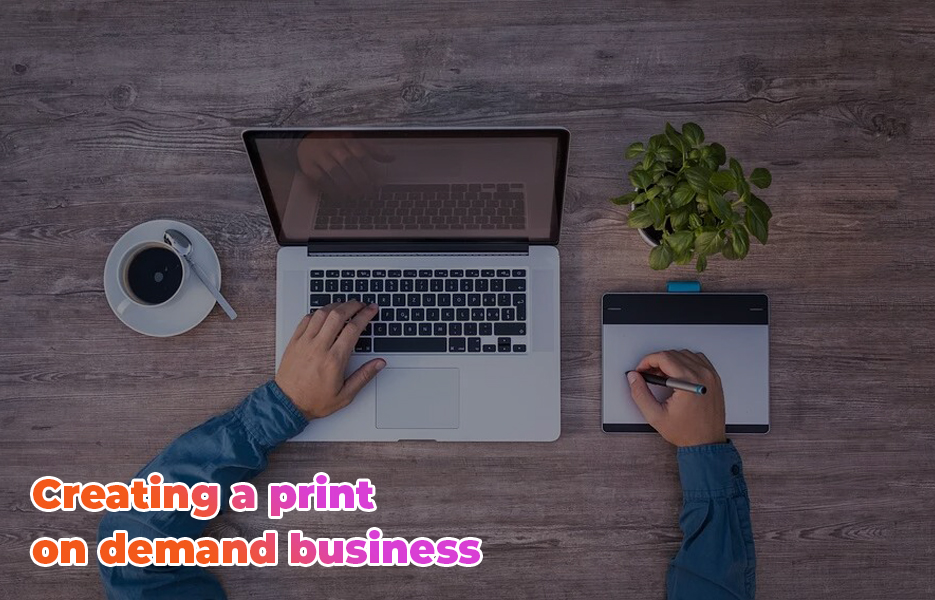
Create your designs
If you’re a talented graphic designer or artist already, then we don’t need to tell you how to do this – it’s already in your blood! However, if your talents lie elsewhere, you have a few options that can help you create a print on demand business.
We’ve mentioned Canva pretty regularly on our blog, but we’re not talking about it because we’re being paid to. We just happen to think that Canva is a great tool for those of us who have an idea what we’re trying to achieve, but don’t have Photoshop, or other skills that we would need to create the finished product. We recommend Canva for simpler designs – like simple logos or text-based designs.
When you’re creating designs, you’ll need to make sure that your print file is suitable for your supplier. Your file needs to be 300 DPI, and have a transparent background. You’ll need to check technical details with your print on demand supplier, to make sure that what you’re going to send them is appropriate. If not, at best your order will be delayed while your supplier checks with you, and at worst, your customer might receive an order that looks completely wrong – meaning you might end up with a complaint, need to offer a refund, or risk getting negative reviews.
If you don’t have an artistic bone in your body, you can outsource your design work using freelance artists. If you don’t know anyone who can do this for you personally, you can access artists and graphic designers and artists on websites like Fiverr, Upwork and People Per Hour.
When you’re working with designers, it’s a good idea to share information about your target customers, and you’ll need to clearly explain exactly what it is you’re looking for. More information is better, and although some designers might work with you by email, having a call might serve you both better. If you can do a Skype video call, FaceTime or similar, your designer will be able to get a much better idea of what you’re trying to achieve, because they’ll be able to pick up on your facial expressions and body language. Those non-verbal cues are important – they can you’re your designer pick up on what you’re looking for. Similarly, they’ll be able to give you instant feedback that they’re on the right track, because they’ll be able to do, and show you, initial sketches as you’re discussing ideas.
Produce mock-ups
Unless you’re in a position to order one of everything in your range, and you don’t have great Photoshop or GIMP skills, using mock-up generators is going to be a key tool in promoting, and selling your products. There are multiple mock-up generators, some of which are free and some paid, but the better quality the image, the more chance that your customers will trust your listing and buy from you. Head over to Mark’s blog post to find out more about mock-up generators and which ones we recommend trying.
Finding your print on demand supplier
These companies all come highly recommended when it comes to print on demand. They’re not the only ones out there, and you should absolutely do your research to ensure that you’re going to be happy with the level of service they provide for you and your customers.
Although many print on demand suppliers will be rock-solid businesses that are unlikely to encounter any issues, there is always a chance that a supplier could go out of business with no warning. It’s always wise to have a backup plan, so if this unfortunate situation occurs, you’re not left scrambling to find an alternative supplier – you simply switch to your alternative.
Order samples
You need to be confident in your supplier. If you’re using a supplier that is based hundreds, or thousands of miles away, that you never speak to because all your orders are sent online then ordering samples is a wise decision to make. Your designs might not look exactly as you intended when they are printed – such as if there’s unfortunate letting placement, or perhaps sizing of your image means that the overall impact of your design is lost. If you encounter problems like this, getting in touch with your print on demand supplier is a good idea. They’re experts, and they’re doing this all day, every day – so take their advice about how to resolve any problems like this.
Your finished products need to look exactly as you expected. Check whether your supplier offers discounts for sample items, free shipping and so on. Although if you’re starting your business with very little money to put in, this might seem like an unnecessary expense, it really is an investment in your long-term success. If your product isn’t as great as you expected, you prevent sub-optimal products reaching your customers – which helps to prevent complaints and negative reviews.
Choose shipping options carefully
Although you’re not going to be sending print on demand items yourself, you still need to consider shipping as a concern. You need to manage customer expectations carefully – so you need to know the average delivery time from your supplier. You can’t offer next day delivery if your supplier takes three days to produce and pack your orders – you’ll end up with complaints and potentially need to offer refunds, which can create further issues for you.
If you are able to, include the shipping costs – at least, to domestic customers – in the retail price. If you’ve ever added to cart and then discovered when you go to check out that the item costs half as much again, you’ll understand this point already! However, it has been proven that extra costs like shipping are the reason that over 50% of customers abandon a purchase – so be transparent with shipping costs, or offering ‘free shipping’ (even though you have covered it in the cost of the item).
If you can’t quite cover the cost of shipping in your items and still remain competitive, see if offering conditional free shipping could work for you. Customers may be willing to add another item to their cart to push their order over the required amount to get free shipping – which means you make a little bit more on each order.
If your supplier provides a range of shipping options, customers may be prepared to wait a little longer for less expensive shipping options. Giving your customers the options puts them in control of their decision, and those customers who need their product sooner – because it’s a birthday present that they didn’t get around to ordering until too close to the date, for example – may decide to pay extra, whereas more organised customers can opt for free shipping.
Sell your products and scale your business
Once you have created your range of designs and established your supplier, it’s time to sell! Think about the customers you are hoping to sell to, and sell where they are likely to shop. Check out our post about how to choose your sales channels – if you’re starting your business with very little investment, you’ll need to consider which marketplaces will suit your needs the best. If you can’t pay upfront for listing fees, then you might need to put off selling on eBay until your business is generating profits, for example.
Once you’re at the point of listing products and making sales, you need to keep that momentum going and your profits increasing. That means on top ofadding your products to new marketplaces, making sure you’re marketing your products – making use of social media – and creating new designs to keep customers interested.
Creating a DropShipping business
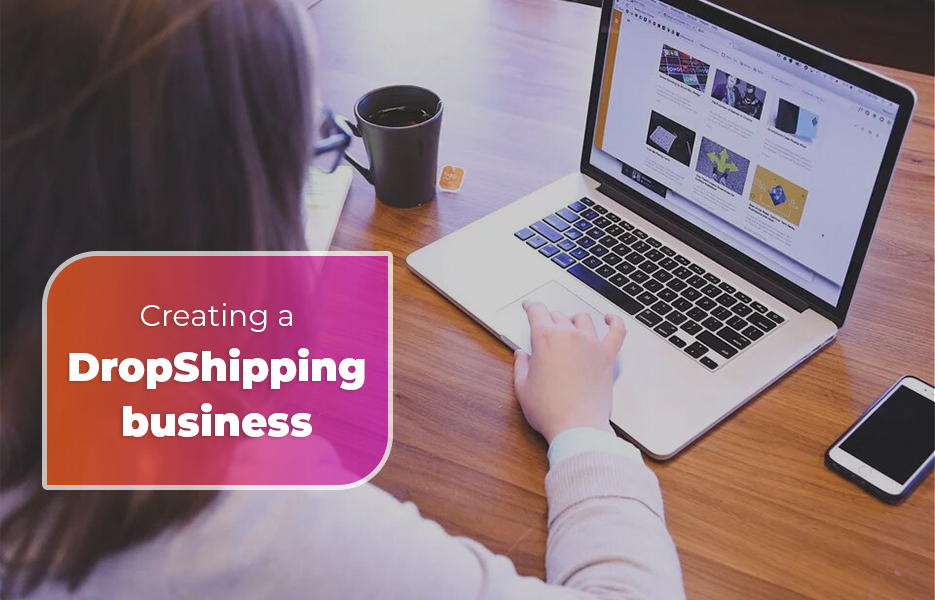
We’ve talked extensively about how to create a DropShipping business on our blog before, in several different posts – so we won’t replicate all that information here. However, the general outline for creating your DropShipping business looks something like this:
- Find a niche
- Establish what is trending
- Find your supplier(s)
- Decide how to engage with your suppliers (are you using a DropShipping platform?)
- Sell on marketplaces
- Sell on your website
- Market your products
- Grow your business further
It’s pretty similar to creating a print on demand DropShipping business – the major difference being is that you’re not having to create the designs for your products.
Similarities between print on demand and regular DropShipping
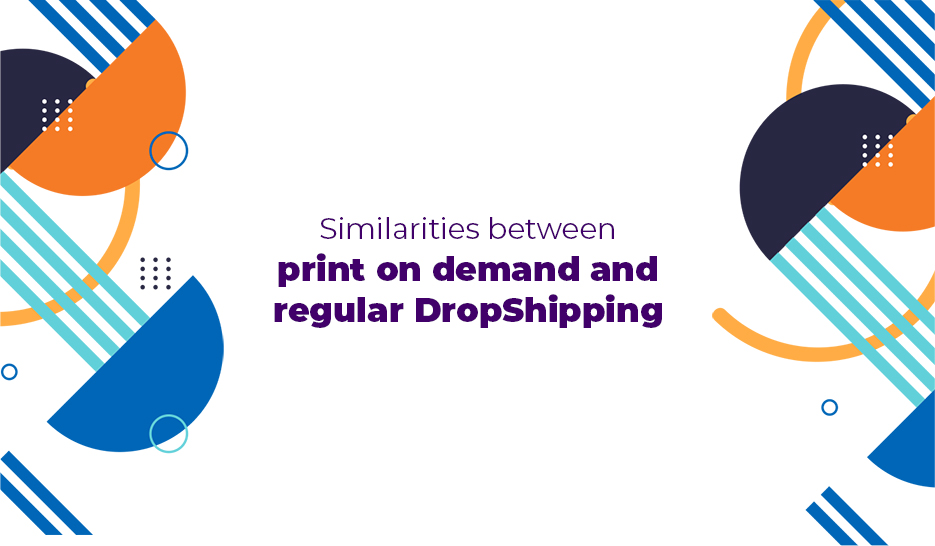
If you’re reading this and thinking that print on demand and regular DropShipping are pretty similar – well, you’re not wrong! There are some key differences, and we’ll get to those in a moment – but the two models have a lot in common.
Essentially, print on demand is a type of DropShipping – just with the extra step of you having to create the products, so all those benefits that you see with DropShipping also apply to print on demand. No upfront costs, no issues with inventory, and no dealing with picking, packing, and dispatching.
With most companies, order processing is automated. That means generally, all you will need to do is click through to send order details to your print on demand supplier.
Both print on demand and DropShipping are low cost, and low risk. You’re not buying items and storing them, and you’re not paying for anything (apart from marketing, and design costs) until your customer has already paid.
To make sales using both print on demand and DropShipping, you’ll need similar skills – to be able to effectively market your products, handle customer service and create marketing campaigns that really deliver.
Mixingprint on demand with other businesses
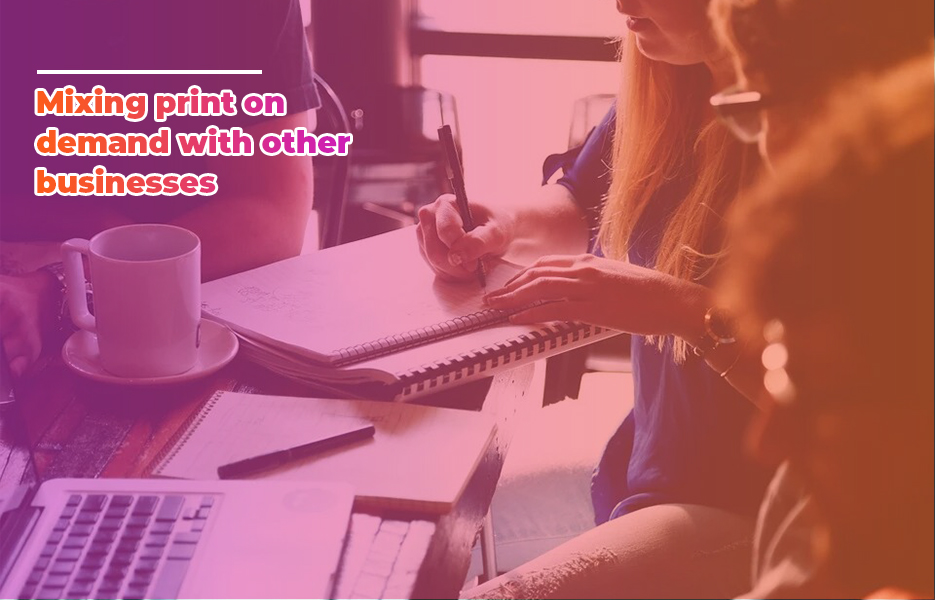
Print on demand is an incredibly flexible way to add to another business – whether the business is an existing one that wants to extend their offering, or a new business that is looking for special editions as promotional items, giveaways and so on. Let’s take a look at what print on demand can do for other businesses – and how DropShipping in particular can support a business selling print on demand items.
Print on demand with existing business
The beauty of print on demand is that there is absolutely no risk. You’re not paying for anything until you’ve made a sale, and once you have connected with your print on demand supplier, it is easy to send the order and get it sent to your customer.
Print on demand services can be used by existing businesses for:
Testing new ideas for your business. If you’ve got an idea that you’re not quite sure whether your customers will love or hate, you can use print on demand to sell those first few products, before you decide whether to invest in stock or not.
Monetising your audience, or existing customers. If part of your business is being a social media influencer, or you create niche items that you hope to build into a cult brand, having print on demand items available for customers to support you and to help increase brand awareness is a great idea. You might choose to use print on demand items for giveaways, as rewards for customer loyalty, or as a free gift with a certain number of items purchased.
Making original items for customers in a certain niche. If you sell items in a niche that isn’t well-catered for, you might decide to create a line specifically to appeal to those customers. Perhaps you sell board games, or games that are along the lines of Dungeons and Dragons – you might have noticed there are high sales for a particular game, but not very much official merchandise available. If that’s the case, print on demand can help you to make additional sales, while satisfying customer demand – either until officially licensed products are available, or until demand drops off.
Create one-off items. Customers might contact you to see if you are able to source something they are looking for – especially in traditional bricks-and-mortar stores. If you’re able to help by ordering exactly what they are looking for from your print on demand supplier, then you’ll benefit from repeat business, good word-of-mouth recommendations, and potentially more of the same!
Print on demand with DropShipping
Selling print on demand items may not be enough – in the beginning, at least – to provide an income you can live on. That means, if you’re trying to quit that awful job that you hate sooner rather than later, or you’re temporarily unemployed, you might be looking for other ways to make more money.
If you’ve read about multichannel DropShipping, and you’re pondering which one to go for – that or print on demand – you’ll no doubt be wondering whether you can combine a print on demand business with a DropShipping business. The fact that we’ve included a section in this post should give the answer away that the answer is absolutely, yes!
If your ultimate goal is to create your own range of products that you’re starting with print on demand, you might decide to create a DropShipping business to support yourself while your print on demand business increases. Once you’re solvent, and your print on demand items become popular enough, you might invest the profits from your business in stock – starting with your top five best selling print on demand products, perhaps. Eventually, you’ll grow sufficiently to only need to do print on demand when you’re testing new items, and potentially even make it to the position that you don’t need to do DropShipping anymore – or rather, it’s not the main focus of your business.
Does print on demand or regular DropShipping make more money?
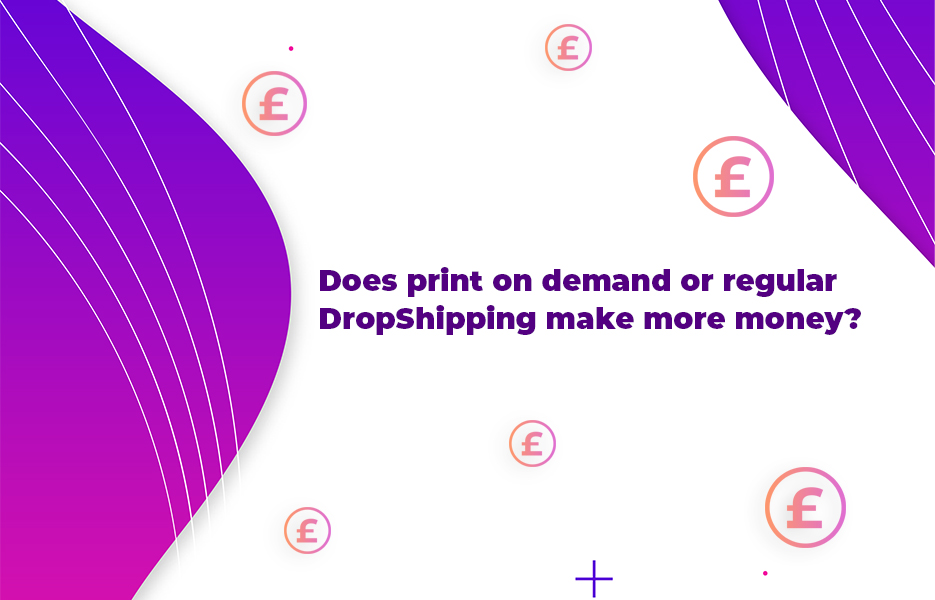
With DropShipping, you have the potential to list – and therefore sell – more products. When you’re using print on demand, you’re having to create your designs as well as marketing them. You’d have to be pretty busy in order to match the thousands of products you could potentially be selling from your DropShipping platform!
It really depends on what you’re selling, and your marketing strategy, ultimately. A fantastically talented designer with a strong marketing strategy planned could easily outperform a regular DropShipping business with a weaker strategy.
Ultimately, both print on demand and regular DropShipping have potential to make you money – it all depends on you, and how well you can produce your designs.
Printing books on demand

Printing books on demand works in much the same way as printing other items on demand. However, printing books on demand presents you with a completely different set of challenges.
Clearly, one of the major challenges to publishing books on demand is the time that it takes to produce the content of the books. We know that writing can be a lengthy process – writing thousands of words simply takes a lot of time! Then there’s the review and editing process – it’s not fast. Even if you’re writing stories for children, there will be a lot of work before you’re ready to consider publishing.
If you’re looking to print books of photographs, comic strips or how-to guides on demand – anything with more graphical content than word count – then you might be ready to sell your book quicker than if you’re writing a novel. In this case though, your cost per item printed will be even higher, which can deter potential customers.
Costs of printing books on demand means that the total cost per book are significantly higher – and many of us have become accustomed to buying paperbacks relatively cheaply, thanks to Amazon (amongst others!). Paying big bucks for a paperback, just isn’t something that many people can afford to do, or are interested in doing. But that doesn’t mean you shouldn’t write that book, or try to get people interested in it. Self-publishing your work, especially if it results in great sales, can lead to interest from a publishing house – who could make producing thousands of copies, and promoting it everywhere, a reality.
Alternatives to printing books on demand
Rather than creating hardback, or paperback books, if you have a book to sell then getting it into the hands of readers can be faster and less expensive by self-publishing it as an eBook. The number of readers that are likely to use a device like a Kindle, Nook, Kobo or a smartphone or tablet with eBook reader apps installed is increasing daily – meaning thatpublishing your work this way can enable you to make sales.
If this is something you fancy considering, here are the seven most popular places to sell eBooks online:
Amazon Kindle Direct Publishing
Apple iBooks Author
Kobo Writing Life
Smashwords
Draft2Digital
These aren’t the only places that you might be able to make sales of your eBook, and of course once you’ve published your work on these platforms, your work isn’t done. You’ll want to promote your work, to increase the chances of people actually downloading it, and then – if you want to, of course – you’ll want to start work on your next book.
There’s much more to it than just what we’ve touched on here – but these are some of the main challenges – writer’s block aside – that you might encounter with creating print on demand books.
Whether you decide to create a business selling solely print on demand products, solely DropShipping, or a combination of the two, we hope that you find the advice we’ve put together here useful. And of course, we wish you the very best of luck with your business now, and in the future. If you’re thinking about setting up a DropShipping business with a print on demand element, and are wondering how Avasam can fit into your plans – get in touch!
This post contains affiliate links. If you use these links to buy something, we may earn a commission. We only use referral links for businesses that we would use ourselves. Thanks for your support!

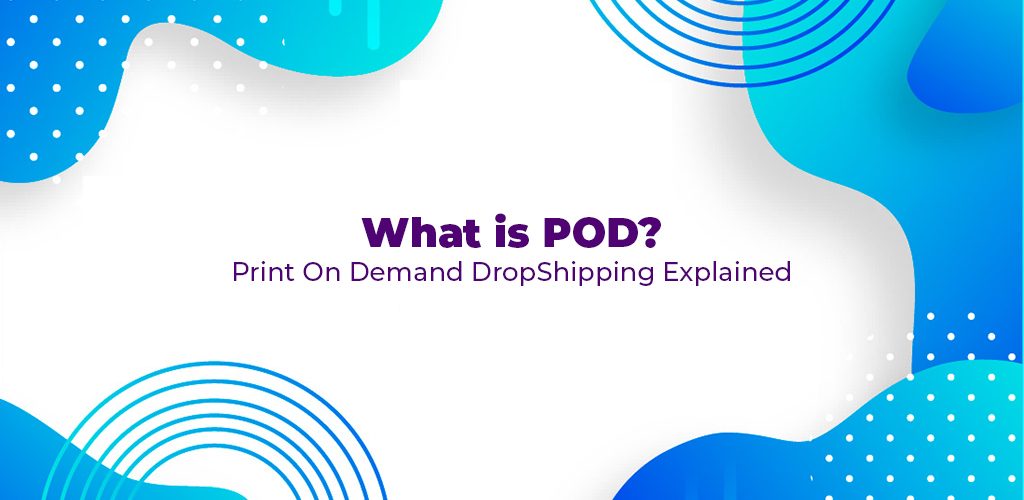


DropShip products from verified suppliers to diversify your inventory and scale your eCommerce business